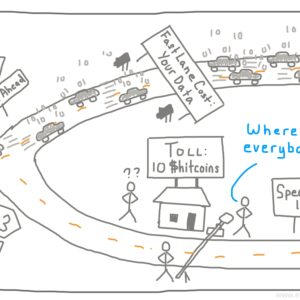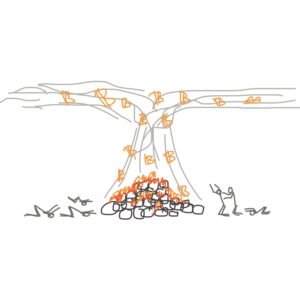Ruby Explained: Objects and Methods
This post will cover objects, methods and some things about classes in Ruby
"Everything in Ruby is an Object" is something you’ll hear rather frequently. "Pretty much everything else is a method" could also be said. The goal here is for you to see the Matrix… that everything in Ruby is an Object, every object has a class, and being a part of that class gives the object lots of cool methods that it can use to ask questions or do things. Being incredibly object-oriented gives Ruby lots of power and makes your life easier.
Think of every "thing" in Ruby as a having more than meets the eye. The number 12 is more than just a number… It’s an object and Ruby lets you do all kinds of interesting things to it like adding and multiplying and asking it questions like > 12.class or > 12+3
Ruby gives all objects a bunch of neat methods. If you ever want to know what an object’s methods are, just use the #methods method! Asking > 12345.methods in IRB will return a whole bunch of methods that you can try out on the number 12345. You’ll also see that the basic operators like + and - and / are all methods too (they’re included in that list). You can call them using the dot > 1.+2 like any other method or, luckily for you, Ruby made some special shortcuts for them so you can just use them as you have been: > 1+2
Some methods ask true/false questions, and are usually named with a question mark at the end like #is_a?, which asks whether an object is a type of something else, e.g. 1.is_a?Integer returns true while "hihi".is_a?Integer returns false You’ll get used to that naming convention. Methods like #is_a?, which tell you something about the object itself, are called Reflection Methods (as in, "the object quietly reflected on its nature and told me that it is indeed an Integer"). ::class was another one we saw, where the object will tell you what class it is.
What is a method? A method is just a function or a black box. You put the thing on the left in, and it spits something out on the right. Every method returns something, even if it’s just nil.
Some methods are more useful for their Side Effects than the thing they actually return, like #puts That’s why when you say > puts "hi" in IRB, you’ll see a little => nil down below… the method prints out your string as a "side effect" and then returns nil after it’s done. When you write your own methods, if you forget to think about the return statement, sometimes you’ll get some wierd behavior so always think about what’s going in and what’s coming out of a method.
Methods can take inputs too, which are included in parentheses to the right of the method name (though they can be omitted, as you do with > puts("hi") becoming > puts "hi".. it’s okay to be lazy, as long as you know what you’re doing). Going back to the addition example, > 1+2==3 is asking whether 1+2 will equal 3 (it returns => true), but it can more explicitly be written > 1.+(2).==(3) So, in this case, you can see there’s more going on than meets the eye at first.
That example also shows Method Chaining, which is when you stick a bunch of methods onto each other. It behaves like you’d expect — evaluate the thing on the left first, pass whatever it returns to the method on the right and keep going. So > 1+2==3 first evaluates 1+2 to be 3 and then evaluates 3==3 which is true This is great because it lets you take what would normally be many lines of code and combine them into one elegant expression.
Bang Methods are finished with an exclamation point ! like #sort!, and they actually modify the original object. The exclamation point lets you know you’re in dangerous territory. Remember, when you run a normal method in IRB, it will output whatever the method returns but it will preserve the original object. Bang methods save over the original object (they are "destructive"):
> my_numbers = [1,5,3,2]
=> [1, 5, 3, 2]
> my_numbers.sort
=> [1, 2, 3, 5]
> my_numbers
=> [1, 5, 3, 2] # still unsorted
> my_numbers.sort!
=> [1, 2, 3, 5]
> my_numbers
=> [1, 2, 3, 5] # overwrote the original my_numbers object!
Methods ending with a question mark ? return true or false.
Let’s answer the question, "Where did all those methods come from?" Classes are like umbrellas that let us give an object general behaviors just based on what it is. An object is an instance of a class — you (yes, you) are an instance of the Person class. There are lots of behaviors (methods) that you can do just by virtue of being a Person… #laugh, #jump, speak("hello") This is really useful in programming because you often need to create lots of instances of something and it’s silly to have to rewrite all the methods you want all of them to have anyway, so you write them at the class level and all the instances get to use them.
Instances of a class get to inherit the behaviors of that class. Inheritance works for classes too! Your class Person has lots of methods but many of them are inherited just by virtue of you also being a Mammal or even just a LivingThing You get to use all the methods of your ancestor classes
An interesting exercise to try in Ruby is to use the method ::superclass to ask a class what its parent is. If you just keep on going and going, you’ll see that everything eventually inherits from BasicObject, which originates most of the methods you have access to in the original object:
> 1.class.superclass.superclass.superclass
=> BasicObject
> BasicObject.methods
=> # giant list of methods
Random Note: Running the ::methods method on a class only returns the class methods, whereas ::instance_methods will return all methods available to any instance of that class (so String.methods will return a list of class methods, while "hello".methods will return a longer list that is the same as String.instance_methods).
Other Random Note: Use object_id to see an object’s id, and this can be useful if you’re running into odd errors where you thought you were modifying and object but it’s not changing. If you debug and look at the id’s along the way, you may find that you’re actually only modifying a COPY of that object.
To Write Your Own Methods, just use the syntax def methodname(argument1, argument2), though the parentheses around the arguments are optional. The method will return ("spit out") either whatever follows the return statement or the result of the last piece of code that was evaluated (an Implicit Return statement). You call the inputs by whatever name you defined them at the top.
You can write methods in IRB… it will let you use multiple lines if it detects that you have unfinished business (a def without an end or unclosed parentheses):
> def speak(words)
> puts words
> return true
> end
=> nil # ignore this
> speak("hello!")
hello!
=> true
What if you want to assume that the input to a method is a particular value if there hasn’t been any supplied? That’s easy, just specify the Default Input by assigning it to something where it’s listed as an input:
> def speak(words="shhhhh")
> puts words
> end # implicitly returns what puts returns... nil!
=> nil # ignore this
> speak # no input
shhhhh
=> nil
*The “Ruby Explained” posts are designed to be a sort of “In-Plain-English” version of key Ruby concepts which are usually covered in other introductory texts but rarely for free and often incompletely. When I’m learning a new thing, I usually want someone to explain it to me like I’m a five year old because that’s the best way to make sure nothing gets missed. This is my attempt to pass that same sentiment on to you. Let me know if there’s anything I can improve.*
If you’re just getting interested in this stuff, check out The Odin Project for a free curriculum to learn web development.






